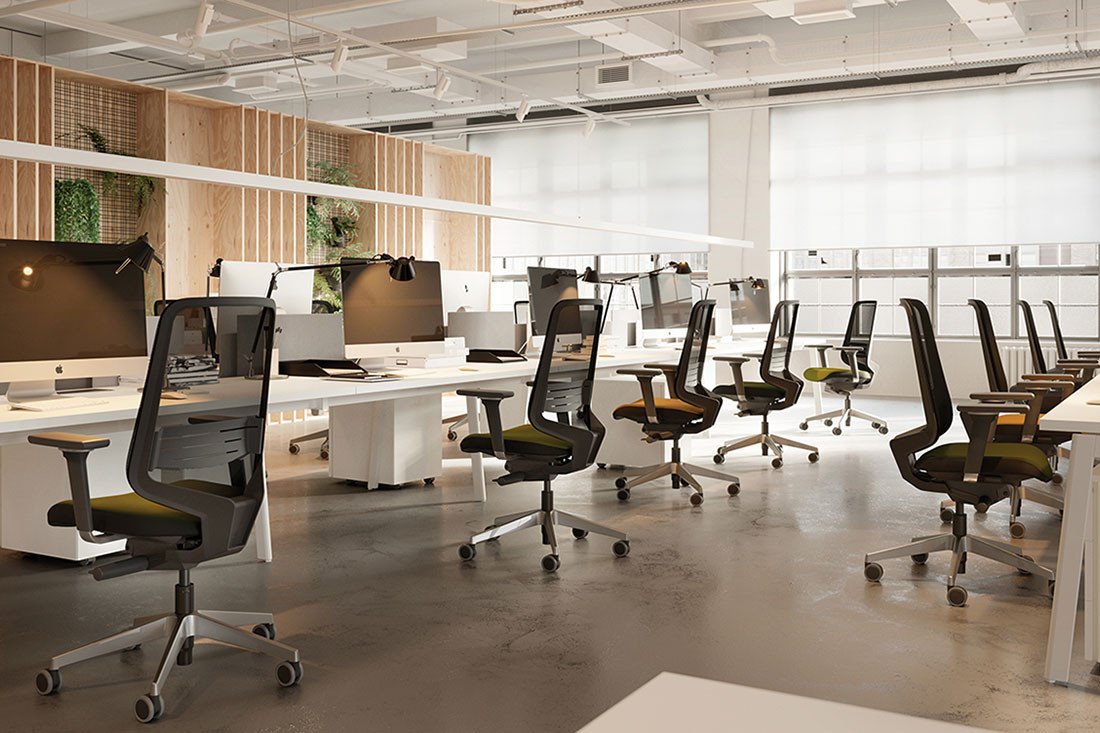
Ergonomic Office Chairs: Finding Balance Between Comfort and Functionality
- Feb 21, 2024
- | 39
In today's modern workplaces, where employees spend a significant portion of their day seated at desks, finding the right balance between comfort and functionality in office chairs is crucial.
Ergonomic office chairs are designed to prioritize both aspects, providing users with the support they need to maintain proper posture and the functionality required to perform their tasks efficiently. Let's explore how ergonomic office chairs strike a balance between comfort and functionality:
Optimal Lumbar Support
One of the key features of an ergonomic chair is optimal lumbar support. The lumbar region of the spine naturally curves inward, and sitting for extended periods without proper support can lead to discomfort and back pain. Ergonomic chairs are designed with adjustable lumbar support features that allow users to customize the level of support to their individual needs.
Proper lumbar support helps maintain the natural curvature of the spine, reducing strain on the lower back muscles and promoting good posture. By providing adequate support to the lumbar region, ergonomic chairs help alleviate discomfort and fatigue, allowing users to remain comfortable and focused throughout the workday.
This balance between support and comfort is essential for preventing musculoskeletal issues and promoting overall well-being in the workplace.
Adjustable Features
Another hallmark of ergonomic chairs is their adjustable features, which allow users to tailor the chair to their unique body dimensions and preferences. These adjustable features include seat height, armrest height and width, seat depth, and recline angle. By offering a range of customization options, ergonomic chairs ensure that users can find the most comfortable and ergonomic seating position for their needs.
Adjustable features also contribute to the functionality of an ergonomic office chair by accommodating a variety of work tasks and environments.
For example, chairs with adjustable armrests can be raised or lowered to support proper arm and wrist alignment during typing, while chairs with recline mechanisms allow users to lean back and relax during breaks or meetings.
The ability to adjust the chair's settings promotes flexibility and adaptability, enabling users to stay comfortable and productive in diverse work situations.
Breathable Materials
Comfort in ergonomic office chairs is further enhanced by the use of breathable materials in the seat and backrest upholstery. Traditional office chairs often feature upholstered cushions that can trap heat and moisture, leading to discomfort and sweating, especially during prolonged sitting periods.
Ergonomic chairs, on the other hand, utilize breathable materials such as mesh fabric, which allow air to circulate freely, keeping users cool and comfortable throughout the day.
Mesh upholstery is not only breathable but also flexible, conforming to the contours of the body and providing gentle support without creating pressure points. Additionally, mesh material is durable and easy to clean, making it an ideal choice for office environments where cleanliness and hygiene are paramount.
Durability and Stability
Functionality is also a key consideration in the design of ergonomic office chairs. These chairs are built to withstand the rigors of daily use in a busy office environment, with sturdy frames and durable components that provide stability and support.
Chairs with five-star bases and smooth-rolling casters offer mobility and maneuverability, allowing users to move freely around their workstations without the risk of tipping over or sliding.
Additionally, ergonomic chairs are engineered to meet industry standards for durability and safety, with features such as weight capacity ratings and certification from organizations such as ANSI/BIFMA.
By investing in a high-quality ergonomic chair, users can trust that their seating solution will remain stable and reliable for years to come, providing a functional and comfortable foundation for their work activities.
Aesthetic Design
While comfort and functionality are paramount, aesthetic design also plays a role in the appeal of ergonomic office chairs. These chairs are available in a variety of styles, colors, and finishes to complement different office environments and personal preferences.
Sleek, modern designs with clean lines and minimalist aesthetics are popular choices for contemporary workplaces, while classic designs with traditional upholstery appeal to more traditional settings.
The aesthetic design of ergonomic office chairs reflects not only their functional capabilities but also the values and identity of the organizations that use them. By selecting chairs that align with their brand image and corporate culture, companies can create a cohesive and inviting work environment that enhances employee satisfaction and engagement.
Advanced Ergonomic Features
Beyond the basic adjustments like seat height and lumbar support, modern ergonomic office chairs incorporate advanced features to further enhance comfort and functionality. These features include dynamic recline mechanisms that allow users to recline and relax while maintaining proper spinal alignment.
Chairs with synchronous tilt mechanisms enable the seat and backrest to tilt in harmony, promoting natural movement and reducing pressure on the spine.
Additionally, some ergonomic chairs feature adjustable headrests to support the neck and upper spine, especially during tasks that require prolonged periods of concentration. These advanced ergonomic features adapt to the user's movements and preferences, promoting comfort and reducing the risk of strain or discomfort during long hours of sitting.
User-Centric Design
User-centric design principles drive the development of ergonomic office chairs, placing the user's needs and preferences at the forefront of the design process. Manufacturers conduct extensive research and user testing to understand how individuals interact with their chairs and identify opportunities for improvement.
User feedback informs decisions about features, materials, and adjustability options to create chairs that offer the highest levels of comfort and functionality.
User-centric design also considers factors such as anthropometrics, body mechanics, and user behavior to ensure that ergonomic chairs accommodate a diverse range of users and work activities. By prioritizing user experience and usability, ergonomic office chairs become intuitive and easy to use, enhancing user satisfaction and productivity in the workplace.
Investment in Employee Health and Well-being
Choosing ergonomic office chairs is an investment in employee health and well-being, with long-term benefits for both individuals and organizations. By providing employees with comfortable and supportive seating solutions, employers demonstrate their commitment to creating a safe and healthy work environment.
Ergonomic chairs help reduce the risk of work-related injuries and musculoskeletal disorders, leading to fewer sick days, reduced healthcare costs, and improved employee retention rates.
Moreover, investing in ergonomic office chairs can have a positive impact on employee morale, engagement, and job satisfaction. Employees who feel valued and supported by their organization are more likely to be motivated, productive, and loyal.
By prioritizing the health and well-being of their workforce, organizations foster a culture of care and respect that enhances employee performance and contributes to overall business success.
Conclusion
In conclusion, ergonomic office chairs strike a delicate balance between comfort and functionality, providing users with the support they need to stay comfortable and productive throughout the workday.
With features such as optimal lumbar support, adjustable settings, breathable materials, durability, stability, and aesthetic design, ergonomic chairs offer a comprehensive solution to the diverse needs of modern workplaces.
By prioritizing comfort and functionality in their seating choices, organizations can create a healthier, more ergonomic, and more enjoyable work environment for their employees.



2.jpg)

